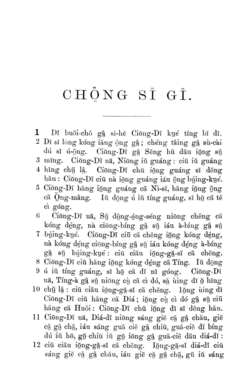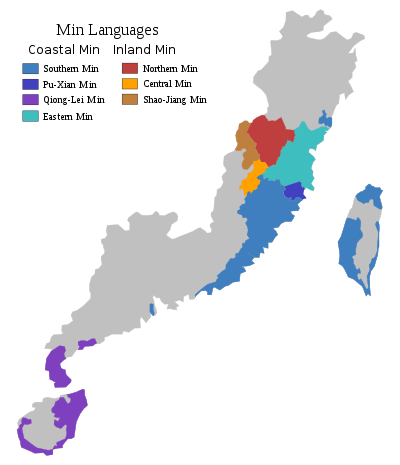Jian'ou dialect
| Jian'ou | |
|---|---|
| Gṳ̿ing-é-dī / 建甌事 | |
| Pronunciation | [kuiŋ˧˧ ɪ˥˦ ti˦˦] |
| Native to | Southern China |
| Region | Jian'ou, Fujian province |
| Chinese character, Kienning Colloquial Romanized | |
| Language codes | |
| ISO 639-3 | – |
| Glottolog |
jian1240[1] |

Jian'ou dialect (Northern Min: Gṳ̿ing-é-dī / 建甌事; Chinese: simplified Chinese: 建瓯话; traditional Chinese: 建甌話; pinyin: Jiàn'ōu huà), also known as Kienow dialect, is a local dialect of Northern Min Chinese spoken in Jian'ou in the north of the Fujian province. It is regarded as the standard common language in Jian'ou.
Phonetics and Phonology
According to The Eight Tones of Kien-chou (建州八音), a rime dictionary which published in 1795, Jian'ou dialect has 15 initials, 34 rimes and 7 tones in the 18th century, however there are only 6 tones in the modern dialect as the "light level" (陽平) tone disappeared.
Initials
| Bilabial | Alveolar | Velar | Glottal | ||
|---|---|---|---|---|---|
| Nasal | m | n | ŋ | ||
| Plosive | voiceless unaspirated | p | t | k | ʔ |
| voiceless aspirated | pʰ | tʰ | kʰ | ||
| Affricate | voiceless unaspirated | ts | |||
| voiceless aspirated | tsʰ | ||||
| Fricative | s | x | |||
| Approximant | l | ||||
Rimes
| Open syllable | Nasal coda | |||||||||||||||
|---|---|---|---|---|---|---|---|---|---|---|---|---|---|---|---|---|
| Open mouth | a | ɪ | ɛ | œ | ʊ | ɔ | ai | au | aŋ | aiŋ | eiŋ | œyŋ | ɔŋ [2] | |||
| Even mouth | i | ia | iɛ | iɔ | iau | iu | iŋ | iaŋ | ieiŋ[3] | iɔŋ | ||||||
| Closed mouth | u | ua | uɛ [4] | uai | uiŋ [5] | uaŋ | uaiŋ | uɔŋ | ||||||||
| Round mouth | y | yɛ [4] | yiŋ [5] | |||||||||||||
Tones
Jian'ou has four tones, which are reduced to two in checked syllables.
| Tone number | Tone name | Tone contour |
|---|---|---|
| 1 | level (平聲) | ˥˦ (54) or ˥ (5) |
| 2 | rising (上聲) | ˨˩ (21) or ˩ (1) |
| 3 | dark departing (陰去) | ˨ (2) |
| 4 | light departing (陽去) | ˦ (4) |
| 5 | dark entering (陰入) | ˨˦ (24) |
| 6 | light entering (陽入) | ˦˨ (42) |
The entering tones in Jian'ou dialect do not have any entering tone coda (入聲韻尾) such as /-ʔ/, /-p̚/, /-t̚/ and /-k̚/ which makes it distinct from many other Chinese varieties.
Footnotes
- ↑ Hammarström, Harald; Forkel, Robert; Haspelmath, Martin, eds. (2017). "Jian'ou". Glottolog 3.0. Jena, Germany: Max Planck Institute for the Science of Human History.
- ↑ /oŋ/ which is mentioned in Kienning Colloquial Romanized has merged into /ɔŋ/ in the modern dialect.
- ↑ /ieiŋ/ is not mentioned in Kienning Colloquial Romanized as it diverged from /iŋ/ after the romanization system was established.
- 1 2 /yɛ/ tends to merge into /uɛ/.
- 1 2 /yiŋ/ tends to merge into /uiŋ/.
References
- Běijīng dàxué zhōngguóyǔyánwénxuéxì yǔyánxué jiàoyánshì. (1989) Hànyǔ fāngyīn zìhuì. Běijīng: Wénzìgǎigé chūbǎnshè.(北京大學中國語言文學系語言學教研室. 1989. 漢語方音字匯. 北京: 文字改革出版社)
- Norman, Jerry. [1988] (2002). Chinese. Cambridge, England: CUP ISBN 0-521-29653-6
- Yuán, jiāhuá (1989). Hànyǔ fāngyán gàiyào (An introduction to Chinese dialects). Beijing, China: Wénzì gǎigé chūbǎnshè. (袁家驊. 1989. 漢語方言概要. 北京:文字改革出版社.)
- Compilation Commission of Chorography of Jian'ou County 建瓯县地方志编纂委员会 (1994). Jian ou xian zhi 建瓯县志 ["Chorography of Jian'ou County"]. 36. Beijing: Zhonghua Book Company. ISBN 7-101-01283-3.
External links
- Lien, Chinfa (1990). "Competing final systems in the Jian'ou dialect" (PDF). Tsing Hua Journal of Chinese Studies. 20 (1): 1–53.
- Cantonese and other dialects (in Chinese)
- Classification of Northern Min Dialects from Glossika
- Jian'ou Romanized Vernacular Bible
